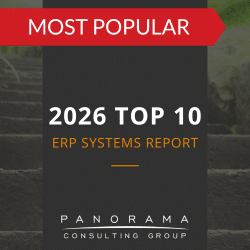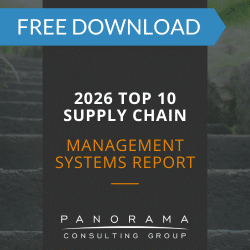An ERP implementation can confound and overwhelm even the most seasoned business leader. Wouldn’t it be great if someone could give you a roadmap of ERP implementation best practices and steps to follow for a seamless integration process? You’d know which steps to take, and you could avoid some of the common mistakes.
With today’s cheat sheet, you can gain access to the insider tips you need. This guide will give you a general overview of how to implement an ERP system.
Cheat Sheet of ERP Implementation Best Practices, Tips, & Tricks and Next Steps
1. Build a Project Team
You can’t achieve implementation success if your team only includes IT execs. Your project team should include stakeholders across your organization from various departments.
These team members can serve as executive sponsors, project managers, change management leads and fill other important project roles.
The 2026 Top 10 ERP Systems Report
What vendors are you considering for your ERP implementation? This list is a helpful starting point.
2. Plan for Data Migration
While your ERP vendor is configuring your system based on your business requirements, this is a good time to start planning how you’ll approach data migration and cleansing. Skipping this step could mean weighing your new platform down with old, incomplete, or duplicate data.
Only after you have reviewed all your data and purged anything that is inaccurate or unnecessary, should you perform data migration.
3. Design Test Cases
There are many different types of testing you should conduct during your ERP implementation. These include:
- Business process testing
- Systems integration testing
- User acceptance testing
- Performance testing
Regardless of the type of testing, developers should create test cases. The percentage of passing cases should determine if you’re ready to move to the deploy phase.
4. Don’t Forget End-User Training When Implementing A New ERP System
Change can be hard. Any time you introduce a new technology or change up a workflow, you can expect some degree of employee resistance. Most of the time, these emotions are rooted in confusion or doubt about the new ERP system.
You can help alleviate these concerns with a solid end-user training program. Before you go live with the ERP platform, allow employees access to a test environment and provide them with customized training materials relevant to their role.
You should also provide them with real-world test scenarios, so they can see how the system works firsthand.
Training not only prepares your workforce for the changes that lie ahead, but it illuminates any system issues that might exist.
5. Develop a Cutover Plan
Before it’s time to go live with your new ERP solution, you should develop a cutover plan that details the steps you’ll take when the big day comes. The details of this plan will vary depending on your rollout strategy: big bang, phased, or hybrid.
The goal of this plan is to ensure that your production environment is 100% ready, and that there are no outstanding issues that could affect a successful launch.
6. Optimize for the Future
Once end-users are using the system in a production environment, you should listen to their feedback to identify any issues or shortcomings that exist. While you can gain similar insights during the testing phase, nothing is as accurate as a real-world application.
Then, after your go-live date, you should continue to look for ways to improve the system and optimize for the future.
How to Implement a New ERP System the Right Way
Now that you know some of the best practices of how to implement an ERP system, you’re one step closer to realizing your expected benefits.
Of course, it’s impossible to cover every single aspect of an ERP implementation in a single blog post. That’s why we suggest scheduling a free consultation so our ERP consultants can provide more details. Contact us below to get started.














